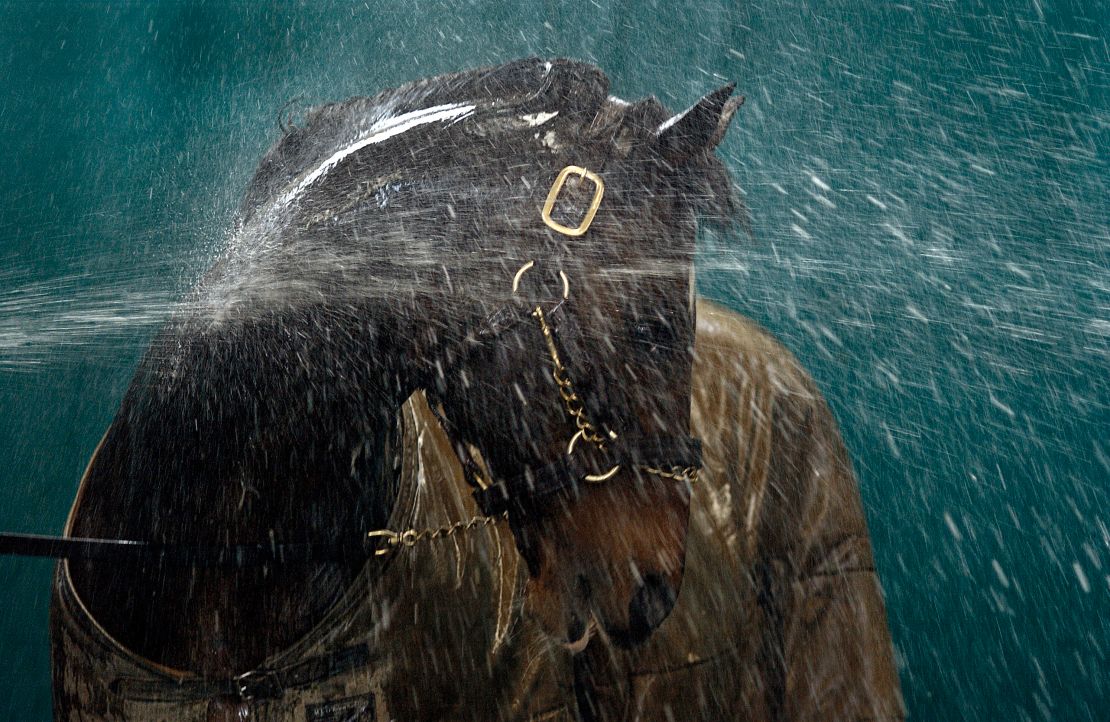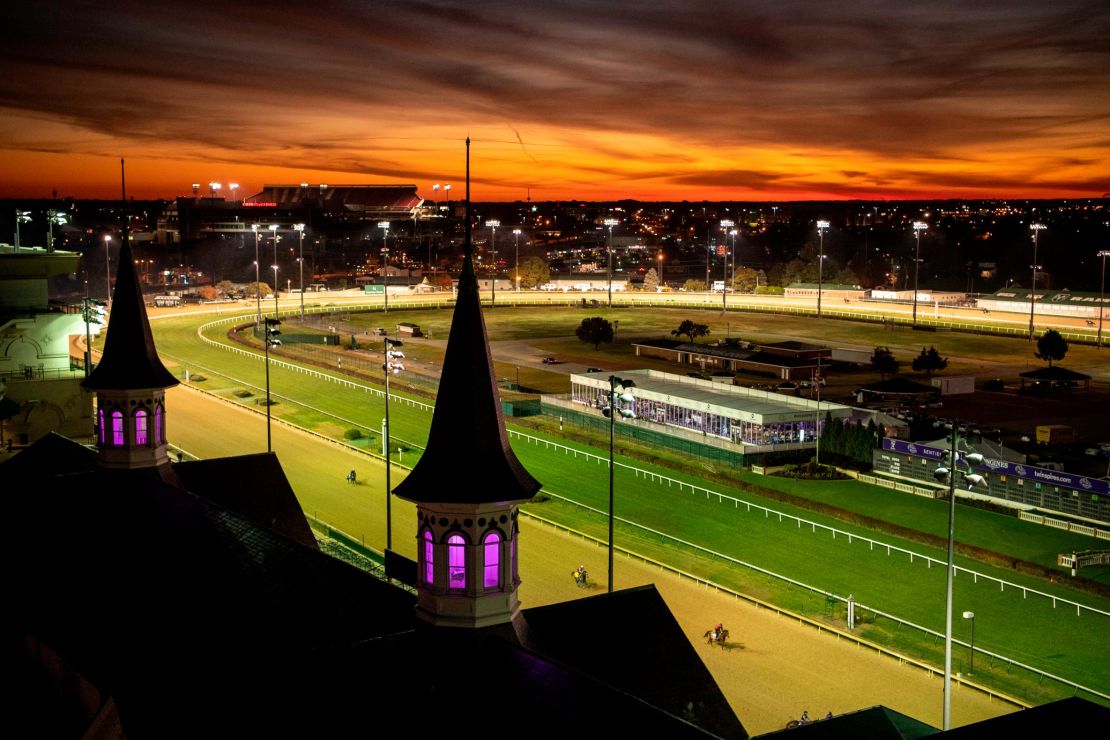His father was a legendary royal correspondent, but when young Edward Whitaker tagged along to watch Prince Charles play polo he was more fascinated by the phalanx of photographers.
From that early interest blossomed an illustrious career in which Whitaker has become a doyen of horse racing photography.
Last year Whitaker won racing’s photographer of the year award for the eighth time as well as picture of the year with his stunning image of a horse in front of a super blue blood moon.
The lunar occurrence is rare – happening every 150 years or so – and so Whitaker was determined not to miss his moment.
He recruited the help of trainer Nicky Henderson’s secretary Carolyn Harty to pose on her horse, and they set off before dawn for the Mandown gallops in Lambourne, England on January 31, 2018.
“I knew a place where the moon set and where the angle would be right, so I was at the bottom of the hill shooting up to the top,” he told CNN Sport.
“It’s about the moon, isn’t it, but the way the horse is arching his neck – there is something very pleasing about it.”
The image was part of a portfolio of six which earned Whitaker the photographer of the year award as well as the main picture prize, the first time anyone has done the double.
“Photography is very subjective, you do what you can and you just hope people enjoy your work. It’s nice when it’s acknowledged and you’re recognised by your peers,” said Whitaker, whose father James was a well known royal writer and broadcaster.
READ: The world’s richest horse races: How to win $7M in two minutes
The world's most beautiful racecourses
‘The world of horse racing opened up’
His sold his first pictures as a teenager as a result of a trip to the famous Badminton horse trials.
“Back in 1981 a very famous photographer called Tim Graham loaned me a camera and I managed to get a sequence of Princess Anne falling at the water jump at Badminton,” he recalls. “I was paid £50 for those pictures and I knew that was how I wanted to make a living.”
After leaving school he began at the bottom on Fleet Street, the former hub of the UK national newspaper scene, working in the dark room and learning how to develop his own pictures, with the occasional shoot at a football match thrown in.
From there he secured a place at photojournalism college in Sheffield which led to his first job at the Racing Post in 1987. He’s never left.
“I thought it would be a nice stepping stone before I moved onto the mainstream national newspapers but I’ve stayed there ever since,” he says.
“The world of horse racing opened up to me and I saw how varied it was for different photographic disciplines.
“I’m very happy I stayed there really. I like the people in horse racing, from the owners and trainers to jockeys and stable staff and the people who work at the tracks. It’s very helpful makes the job a lot easier when people want to be photographed.”
READ: Is this racing’s most unique horse?
‘Blown away’

One of his early successes came on his first trip to the famous Breeders’ Cup at Churchill Downs in the United States as a 26-year-old in 1991.
Using a remote camera triggered by a wire under the rails near the finish line, he took a stunning image of the great French-trained horse Arazi winning the Breeders’ Cup Juvenile, a race pitting the top two-year-olds from American against the best of Europe on dirt.
“The Americans, of course, totally ignored the Europeans on dirt and this horse Arazi ran this unbelievable race, like something from a movie,” he says.
“He came around the back stretch in last place and went through the field like it was ‘National Velvet’ or some ridiculous film like that and he won by about six lengths.
“I got this image of jockey Pat Valenzuela, this extroverted American, screaming his head off on the horse against the spires of Churchill Downs.
“It was way before Frankie Dettori. We’d never seen anything like it in a European race. They were very strong images and it was a big breakthrough.
“It really helped my career. I’d just been sent out to the US to see what I could get, but my lot were blown away. No one else was doing remotes in Europe at this time. And Arazi’s win is still talked about as one of the great Flat horse races.”
READ: American Saddlebred: The horse that America made
‘Light, composition, action’

Another image that has helped to define Whitaker’s career is an early digital picture of the great stallion Danehill being hosed down at Coolmore Stud in Ireland in 2003.
“I just love the whole effect of this picture, how the water is reacting over the horse,” says Whitaker. “He turns his neck so it was almost like a massage to him, and you can see how much he’s enjoying it.
“I had to shoot it on a slow shutter speed and there’s a real sense of movement in the water, rather than freezing it with a fast shutter, and the light is just lovely.”
The key to capturing a striking image is “light, composition and action,” according to Whitaker. Often, he says he is “shooting life in the background” and the subject “just happens to be a horse.”
Sometimes photographers can be like kids in a sweetshop, he says, as they look back over their images to see what they’ve got.
Occasionally they strike unexpected gold, like his shot of a shoe flying off a hoof at Cheltenham, captured as an upright “lucky horse shoe,” which was part of his winning portfolio.
READ: Why horses can’t see orange

‘Unbelievable colors’

At other times experience, commitment and a bit of cunning are needed, such as his dramatic shot of Churchill Downs.
“I’d established the previous afternoon there was this fire exit up to a door that opened onto the roof so I went up there the following morning and caught this great dawn,” says Whitaker, who also shoots tennis at Wimbledon most years.
“I thought the sky would be very interesting in the sense there was a cold front coming in, so I knew there would be some very dramatic reds and yellows in it.
“And now they light up the iconic spires with purple light, so the colors are unbelievable. It’s so over the top and American, you’ll never quite get that scene anywhere else.”
Things are changing, though. Although horses falling can make for dramatic pictures, “public perception is changing,” says Whitaker.
“A lot of people now are very anti fall pictures.” The public are also “very sensitive” about whip shots, he says, even though the symmetry of three jockeys in a line with their whips can make for a strong image.
But horse racing still offers rich pickings for photographers willing to get creative.
“There are so many people shooting horse racing all the time so to get one picture that’s better or stronger than someone else’s you need a lot of elements to come into the equation,” he says.
Fortunately for Whitaker, the winning equation tends to come around more often than once in a blue moon.
Click through the gallery at the top of this page to see some of Edward Whitaker’s favorite shots from his Racing Post career.
















